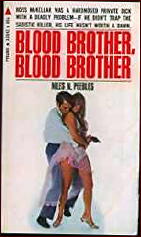Wed 8 Mar 2017
LIAM PHILLIPS on his father, PHILIP ATLEE, Author of the Joe Gall Books.
Posted by Steve under Authors , Bibliographies, Lists & Checklists , Characters , Interviews[16] Comments
Author of the Joe Gall Books:
James Young Phillips, a/k/a James Atlee Phillips, a/k/a Philip Atlee, was my father. The man lived large and was somewhat of an enigma to us all. He was married three times and his last marriage was to my mother, Martha Phillips. Singer-songwriter Shawn Phillips is my half-brother from a previous marriage.
I am the Copyright Holder of Record for all of his written works, excepting the screenplays which are the properties of the studios for whom he wrote them. We are working to get the books into digital format, including an unpublished autobiography, and at least one short story compilation. Jim wrote several unproduced screenplays as well, but the publication rights to those items is a bit more tricky. We will see what happens.
To answer a few questions: My father resisted having his photograph taken under any circumstances. He reluctantly relented for obligatory family functions and even then often did so with a pair of his trademark dark sunglasses on. He was the subject of several newspaper articles over the years and always used the same picture — black turtleneck and dark glasses.
Said photograph was taken for an article published in a Hong Kong newspaper in the late ’60s/early ’70s. There will be plenty of photos in the autobiography, including that one. The work is slow as I am at it by myself and struggled with serious health issues for over a decade. Thankfully, those problems are now fully resolved and I am capable of doing work again.
The man pictured on the cover of the Joe Gall novels is an Irish bartender whose name may be lost to history. He was discovered by either Jim’s agent or a representative of Fawcett/Gold Medal and seemed to fit the description of Joe Gall. He was paid a flat fee for a photograph session and was thereafter pictured on the covers.
We have had numerous inquiries over the years re: Joe Gall film projects. We had Clint Eastwood calling in the ’70s/80s and most recently David Mamet. We’ve also had some discussion about audio books and graphic novel versions, but the process is what it is in each case. There has never been any hesitance or reluctance (or greed) on my part, I can assure you. I, too, am a fan of the works and would love to get them out there for people to enjoy in whatever format I can.
Jim went through life traveling light — he regularly discarded of documentation and paperwork for all aspects of his life. He did so to such a degree that the sum total of his possessions at the end of his life were a few pieces of clothing, a typewriter and a box of blank paper, and a few scribbles on notepads. Clarity on copyright, history, origins, all of that stuff, has been elusive to say the least.
My intention is to get the works, including SOME of the unpublished material, onto Amazon this year. Digitizing via OCR, proofing, artwork – for a 22 book series, plus 5 other novels, and the short stories – is a MASSIVE amount of work for even a group of dedicated people. But we are determined! The autobiography will take a bit longer, what with the photos and so forth. The book itself is quite the read from a very opinionated character who didn’t have a PC bone in his body and we are all the better for it!
I have cruised by Mystery*File over the years, but had nothing to add as I was too ill for even the obligations of a muted correspondence.
I want to thank every single person who has said such positive things about my father and his works (and my brother as well). You are all truly appreciated and recognized. I hope that we can do your interests justice and produce material that meets your standards and that everyone can enjoy. Many thanks to all of you amazing people!
The Joe Gall series —
The Green Wound. Gold Medal k1321, July 1963 [New Orleans, LA]
— Reprinted as The Green Wound Contract, Gold Medal, 1967.
The Silken Baroness. Gold Medal k1489, 1964 [Canary Islands]
— Reprinted as The Silken Baroness Contract, Gold Medal, 1966
The Death Bird Contract. Gold Medal d1632, 1966 [Mexico]
The Paper Pistol Contract. Gold Medal d1634, 1966 [Tahiti]
The Irish Beauty Contract. Gold Medal d1694, 1966 [Bolivia]
The Star Ruby Contract. Gold Medal d1770, 1967 [Burma]
The Rockabye Contract. Gold Medal d1901, 1968 [Caribbean]
The Skeleton Coast Contract. Gold Medal D1977, 1968 [Africa]
The Ill Wind Contract. Gold Medal R2087, 1969 [Indonesia]
The Trembling Earth Contract. Gold Medal, 1969 [U.S. South]
The Fer-de-Lance Contract. Gold Medal, Jan 1971 [Caribbean]
The Canadian Bomber Contract. Gold Medal T2450, August 1971 [Montreal, Canada]
The White Wolverine Contract. Gold Medal T2508, Dec 1971 [Vancouver, Canada]
The Kiwi Contract. Gold Medal T2530, Feb 1972 [New Zealand]
The Judah Lion Contract. Gold Medal T2608, Sept 1972 [Ethiopia]
The Spice Route Contract. Gold Medal T2697, April 1973 [Middle East]
The Shankill Road Contract. Gold Medal T2819, Sept 1973 [Ireland]
The Underground Cities Contract. Gold Medal M2925, Feb 1974 [Turkey]
The Kowloon Contract. Gold Medal M3028, August 1974 [Hong Kong]
The Black Venus Contract. Gold Medal M3187, Feb 1975 [South America]
The Makassar Strait Contract. Gold Medal P3477, March 1976 [Indonesia]
The Last Domino Contract. Gold Medal 1-3587, 1976 [Korea]
